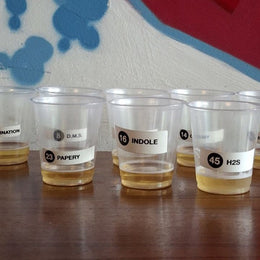What Sets Real 100% Agave Tequila Apart? Patrón’s Additive-Free Tequila Masterclass Gives us a Taste of the Truth

The idea was straightforward: produce a tequila that stands on pure agave, and nothing of else. What sounded like a simple commitment to quality and transparency led Patrón to become the poster child for premium tequila, appearing on back bars from New York to Tokyo within a few short years.
Patrón was only founded in 1989, a relative newcomer in this beloved category. Its story begins with two savvy entrepreneurs who spotted the early signs of a new movement: premium tequila. They launched Patrón just before the premium tequila market in the US exploded sevenfold, quickly setting themselves apart by pioneering the “Tequila 100% De Agave” label that may seem like a common label today, but in fact set a new standard in an industry long plagued by inconsistent quality. It’s little wonder that by 2018, spirits heavyweight Bacardi was ready to acquire Patrón in a deal worth $5.1 billion.

Lauren Mote, Patrón's Global Director for On-Trade Excellence is deeply involved in educational initiatives for the bartending community on tequila and spirits.

With all this history in mind, I recently jumped at the chance to sit in on Patrón’s Advanced Tequila Training—a masterclass run by Lauren Mote, the brand’s Global Director of On-Trade Excellence. Lauren is one of the most renowned spirits and mixology educators in the North American scene, with more than twenty years behind the bar, and experiences as Beverage Consultant for places like the Four Seasons.
So few are better at breaking down the real nuts and bolts of tequila—how it’s made, what the rules really are, and, crucially, what “100% De Agave” means in practice!
Basic Rules of Tequila Production
The Consejo Regulador del Tequila (CRT) is the Mexican authority that keeps a close eye on how tequila is made and what spirit qualifies as one, and the official rules lie in Mexican government regulation NOM-006-SCFI-2012 which sets out the legal standards and requirements for the production, labelling and bottling of tequila .

(Image source: Insightguides.com)
For a start, tequila production is only limited to five regions in Mexico, with Jalisco as the heart of the industry. Every bottle must be distilled from the sugars of cooked Blue Weber agave plant.
Within Jalisco itself, the two big subregions are the Highlands (Los Altos) and the Lowlands (El Valle). Each has its own approach and reputation, but terroir plays a huge role in giving us different taste profiles. Tequila from the Highlands tends to be a bit sweeter, fruitier and more floral, thanks to the cooler climate and red volcanic soils. The Lowlands, on the other hand, put out tequilas that are earthier, spicier, and heavier on the herbal notes–climate and soil differences make a real impact in the glass.
A range of big tequila brands line up within these regions. The Lowlands are home to Jose Cuervo and Fortaleza, while the Highlands lay claim to names like Patrón itself, Ocho and Espolòn.

(Image sources: Patron, Long Island Lou Tequila, Don Julio)
Another important distinction in tequila styles is between those labelled “100% agave tequila” and what’s called mixto tequila (usually just simply labelled as “Tequila”). When you see “100% agave” on the label, it means every drop in that bottle is made from Blue Weber Agave with no extra sugars from other source. Mixto, by contrast, only needs to be made from at least 51% agave, with the rest made up of other fermentable sugars, usually from cane, fruit, or grain. This distinction affects both the taste and the quality of what you’re drinking.
But Lauren's masterclass zeroes in on what it actually takes to make proper “100% agave tequila”. We uncovered a few surprising realities behind the production process that even long-time tequila drinkers might not expect.
On the uses and abuses of Tequila Additives
Here’s where things get a bit murky in the world of “100% agave” tequila. Many serious tequila fans make plenty of chatter about how some of the biggest premium brands aren’t quite as pure as their labels suggest. And they aren’t overreacting.

An extract from an English version of NOM-006-SCFI-2012 which describes the permitted practice of adding "mellowing" agents to certain types of tequila.
The issue boils down to a regulation most casual drinkers have never heard of: NOM-006-SCFI-2012. This rule allows producers to add up to 1% of the tequila’s total weight in additives before bottling, without having to say a word about it on the label.
That’s how a bottle marked “100% agave” can legally contain extras like jarabe (sugar or sweetener syrup), glycerin, oak extract and caramel. These additives aren’t just minor tweaks—they can have a real impact. Jarabe is often made from highly-concentrated non-sugar sweeteners that are hundreds or even thousands of times sweeter than regular sugar. Glycerin is all about texture, giving the tequila a smoother, thicker feel and helping the finish hang around. Oak extract brings in barrel-like notes and a touch of tannin, but without much colour. And caramel? That’s what gives some tequilas their rich, aged look without many years of aging.

Additives are often used to even out flavour differences from batch to batch, or to mimic the depth and smoothness of longer-aged spirits. It’s a common move, especially among producers trying to keep their tequila tasting the same year after year. Some purists see this as cutting corners, while others view the use of additives is more about keeping up with consumer expectations and market realities.
Lauren made a point of staying neutral on the topic. For her, it’s less about demonising additives and more about being upfront about their presence and effects. Patrón, for its part, skips additives entirely. The brand puts its energy into coaxing out as much natural flavour as possible from the agave itself.

To really drive this point home, the Patrón team lined up a tasting for us: tequilas both with and without additives. This was a chance to see, glass in hand, just how much these extras can alter the character of the spirit.
Experiencing the effects of Tequila Additives firsthand
For the tasting, we were handed two sets of generic tequila samples—one of silver (blanco) and another of reposado tequilas. These weren’t from Patrón, but from unnamed producers, to keep things fair and unbiased. The idea was to taste each tequila as it is, then dose it with additives and see what happens.

We kicked off with a generic blanco, free of additives. After a first round of nosing and sipping, we were told to add two drops of glycerin to our glasses. Straight away, you could see the change—the legs of the spirit clung to the glass much more slowly. On the nose, the tequila didn’t shift much, but the texture was completely different. The mouthfeel turned softer and more velvety. Any sharp mint or spice got rounded off, making it go down easier, and the finish stretched out noticeably.

Next came four drops of jarabe. That’s when the flavours really took a turn. Suddenly, the nose was full of green apple and an unmistakable bump in sweetness. The once-neutral blanco, which started out a bit dry and clean, was now full of bright lemon, tutti frutti notes, and even bubblegum.

Moving on, we tried an unadulterated generic reposado. It came across with straightforward aromas of caramel and baking spices, and tasted of light caramel with a dry, spicy finish. Not a bad reposado, but nothing wildly memorable.

Then came the line-up of additives: two drops of glycerin, two of oak extract, one drop each of caramel colouring and jarabe. The first thing we noticed is the colour–the spirit instantly shifted from a pale gold to a deep amber, like an aged Scotch. The nose picked up notes of cola, sarsaparilla, marshmallow, and even a touch of mushroom. On the palate, it became smoother, with caramel and liquorice up front, followed by a much longer finish with black tea and richer spices.

Lauren pointed out that even with all these drops, we were still well below what the law allows in a full bottle. The whole exercise really hammered home how just a dash of additives can completely change the mouthfeel and add layers of flavour that simply aren’t there from distillation alone—qualities that many drinkers take as signs of “premium” tequila.
With those new perspectives in mind, we finally moved on to tasting the real benchmark: Patrón Silver and Patrón Reposado, served for comparison with these.
Patrón Silver

Starting with the Patrón Silver, the first thing I noticed on the nose is that unmistakable roasted agave, followed by gentle pumpkin spice and an unexpected lift from delicate floral notes and a touch of cream. On the palate, there’s a pleasant, light spiciness layered with a subtle nuttiness. The texture stands out– it’s medium bodied, offering a nice weight that doesn’t feel artificially thick or syrupy, but still has some heft.
As the finish lingers, I pick up herbaceous tones, a whiff of fresh oregano, a trace of pine nuts, and a slightly drying sensation.
Patrón Reposado

Moving on to the Patrón Reposado, it’s clear right from the start that this is a much more layered experience compared to the other reposados in the tasting, even those tweaked with additives. On the nose, there’s an interplay of fresh herbs, a hint of green apple, and vanilla. The palate opens up with gentle caramel notes, a faint floral character that brings to mind warm linen and lavender, and even some sweetness of muscat grape. There’s a bit of earthiness, too, that grows with each sip. The mouthfeel is comfortably medium bodied, and the finish leaves a grounded impression—earthy and slightly reminiscent of clay.
Final Thoughts
Stepping back, tasting Patrón’s additive-free tequila side by side with the generic tequilas puts things into perspective. Even without anything to mask or smooth over flaws, Patrón’s spirits feel far more expressive and genuine. There’s a clarity to the flavours– a sense that the agave and the land it was grown on are coming through unfiltered, instead of being layered over with syrup or oak extract.
Compared to generic additive-free brands, Patrón’s tequilas are clearly more expressive. Compared to those dosed with additives, you can get a sense that Patrón’s is still more authentic and nuanced.

From hand harvesting agaves that's transported by donkey, to employing the use of a volcanic rock tahona wheel to crush the agave that's cooked for days in a traditional brick oven, and then fermenting the agave in open top wooden pine vats, to finally distilling the agave in copper stills - Patron is far more traditional than it lets on.
Lauren argued that real tequila should showcase the character of Mexican terroir, letting the unique flavours of agave shine through. When aged properly, the spirit should gain complexity, not lose its roots to overbearing oak or added flavourings.
What’s surprising is that despite Patrón’s global profile and scale, their methods are still rooted in small-batch traditions: copper pot stills, slow cooking, and a focus on hand processes rather than industrial shortcuts. Each batch starts with agave roasted in small brick ovens for a painstaking 79 hours. The juice is extracted using traditional tahona stone mills. Fermentation, which contributes most of the final flavour profile, is slow and designed for maximum development. Distillation is done in small copper pots, allowing for careful selection of the heart cut to keep only the best elements in the final spirit.
It’s a lot of extra effort, but the result is obvious from a side-by-side tasting.

@CharsiuCharlie







